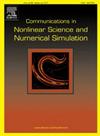Phase shifts inside Arnold tongues of weakly coupled oscillators
IF 3.4
2区 数学
Q1 MATHEMATICS, APPLIED
Communications in Nonlinear Science and Numerical Simulation
Pub Date : 2025-02-28
DOI:10.1016/j.cnsns.2025.108729
引用次数: 0
Abstract
In this paper, we investigate phase synchronization phenomena in weakly coupled oscillators, with a particular focus on the phase shifts that occur within Arnold tongues. Using a proposed theoretical approach, we provide proof of the existence of the corresponding cycle manifold near zero coupling, along with a detailed derivation of its shape. This allows us to explore the conditions under which phase-shift synchronization arises. We employ the implicit function theorem in an appropriate Banach space to establish the existence of the cycle manifold and provide a methodology to study in-phase and anti-phase synchrony in systems governed by both ordinary and delay differential equations. We introduce a numerical technique for cycle continuation that reveals the shift structure of Arnold tongues in coupling and parameter space near the cusps, offering new insights into the dynamics of phase-shifted coupled oscillators. This framework is applied to a classic model of two coupled circle oscillators, coupled van der Pol oscillators, a model of two interneurons, and a two-level interneuronal network to better understand and demonstrate the numerical continuation methodology, which allows for the study of phase synchronization in neuroscience and other fields. The proposed methods not only advance the theoretical understanding of synchronization but also offer practical computational tools for studying complex oscillatory systems.
求助全文
约1分钟内获得全文
求助全文
来源期刊

Communications in Nonlinear Science and Numerical Simulation
MATHEMATICS, APPLIED-MATHEMATICS, INTERDISCIPLINARY APPLICATIONS
CiteScore
6.80
自引率
7.70%
发文量
378
审稿时长
78 days
期刊介绍:
The journal publishes original research findings on experimental observation, mathematical modeling, theoretical analysis and numerical simulation, for more accurate description, better prediction or novel application, of nonlinear phenomena in science and engineering. It offers a venue for researchers to make rapid exchange of ideas and techniques in nonlinear science and complexity.
The submission of manuscripts with cross-disciplinary approaches in nonlinear science and complexity is particularly encouraged.
Topics of interest:
Nonlinear differential or delay equations, Lie group analysis and asymptotic methods, Discontinuous systems, Fractals, Fractional calculus and dynamics, Nonlinear effects in quantum mechanics, Nonlinear stochastic processes, Experimental nonlinear science, Time-series and signal analysis, Computational methods and simulations in nonlinear science and engineering, Control of dynamical systems, Synchronization, Lyapunov analysis, High-dimensional chaos and turbulence, Chaos in Hamiltonian systems, Integrable systems and solitons, Collective behavior in many-body systems, Biological physics and networks, Nonlinear mechanical systems, Complex systems and complexity.
No length limitation for contributions is set, but only concisely written manuscripts are published. Brief papers are published on the basis of Rapid Communications. Discussions of previously published papers are welcome.
 求助内容:
求助内容: 应助结果提醒方式:
应助结果提醒方式:


